
初学者试机轨迹g代码
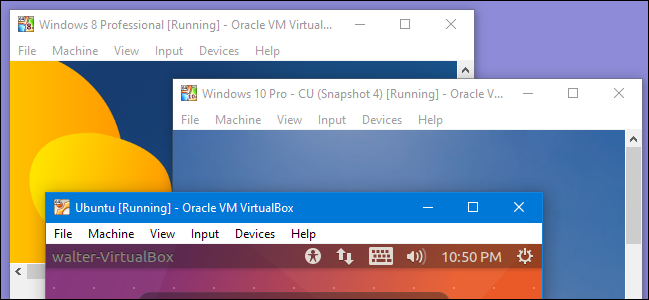
Virtual machines allow you to run an operating system in an app window on your desktop that behaves like a full, separate computer. You can use them play around with different operating systems, run software your main operating system can’t, and try out apps in a safe, sandboxed environment.
虚拟机允许您在桌面上的应用程序窗口中运行操作系统,该操作系统的行为就像一台完整的独立计算机。 您可以使用它们在不同的操作系统上玩耍,运行主操作系统无法运行的软件,并在安全的沙盒环境中试用应用程序。
There are several good free virtual machine (VM) apps out there, which makes setting up a virtual machine something anybody can do. You’ll need to install a VM app, and have access to installation media for the operating system you want to install.
有好几个不错的免费虚拟机(VM)应用程序,这使设置虚拟机成为任何人都可以做的事情。 您需要安装VM应用程序,并有权访问要安装的操作系统的安装介质。
什么是虚拟机? (What’s a Virtual Machine?)
A virtual machine app creates a virtualized environment—called, simply enough, a virtual machine—that behaves like a separate computer system, complete with virtual hardware devices. The VM runs as a process in a window on your current operating system. You can boot an operating system installer disc (or live CD) inside the virtual machine, and the operating system will be “tricked” into thinking it’s running on a real computer. It will install and run just as it would on a real, physical machine. Whenever you want to use the operating system, you can open the virtual machine program and use it in a window on your current desktop.
虚拟机应用程序会创建一个虚拟化环境(简称为虚拟机),其行为类似于单独的计算机系统,并带有虚拟硬件设备。 VM作为进程在当前操作系统上的窗口中运行。 您可以在虚拟机内部引导操作系统安装光盘(或实时CD),并且操作系统将被“欺骗”以使其在真实计算机上运行。 它会像在真实的物理计算机上一样安装和运行。 每当您要使用操作系统时,都可以打开虚拟机程序,并在当前桌面的窗口中使用它。
In the VM world, the operating system actually running on your computer is called the host and any operating systems running inside VMs are called guests. It helps keep things from getting too confusing.
在VM世界中,实际在计算机上运行的操作系统称为主机,而在VM内部运行的任何操作系统称为来宾。 它有助于防止事情变得过于混乱。
In a particular VM, the guest OS is stored on a virtual hard drive—a big, multi-gigabyte file stored on your real hard drive. The VM app presents this file the guest OS as a real hard drive. This means you won’t have to mess around with partitioning or doing anything else complicated with your real hard drive.
在特定的VM中,来宾操作系统存储在虚拟硬盘驱动器上,这是一个很大的千兆字节文件,存储在您的实际硬盘驱动器上。 VM应用程序将此文件作为真正的硬盘驱动器呈现给来宾OS。 这意味着您将无需再进行分区或使用实际硬盘进行任何其他复杂的处理。
Virtualization does add some overhead, so don’t expect them to be as fast as if you had installed the operating system on real hardware. Demanding games or other apps that require serious graphics and CPU power don’t really do so well, so virtual machines aren’t the ideal way to play Windows PC games on Linux or Mac OS X—at least, not unless those games are much older or aren’t graphically demanding.
虚拟化确实增加了一些开销,因此不要期望它们像在真实硬件上安装操作系统一样快。 要求苛刻的游戏或其他需要大量图形和CPU能力的应用程序的确不能做到如此出色,因此虚拟机并不是在Linux或Mac OS X 上玩Windows PC游戏的理想方式-至少,除非这些游戏很多,否则年龄较大或图形要求不高。
The limit to how many VMs you can have are really just limited by the amount of hard drive space. Here’s a peek at some of the VMs we use when testing things out while writing articles. As you can see, we’ve got full VMs with several versions of Windows and Ubuntu installed.
您可以拥有的VM数量的限制实际上仅受硬盘驱动器空间量的限制。 这是我们在撰写文章进行测试时使用的某些VM的一瞥。 如您所见,我们已经安装了具有多个Windows和Ubuntu版本的完整VM。
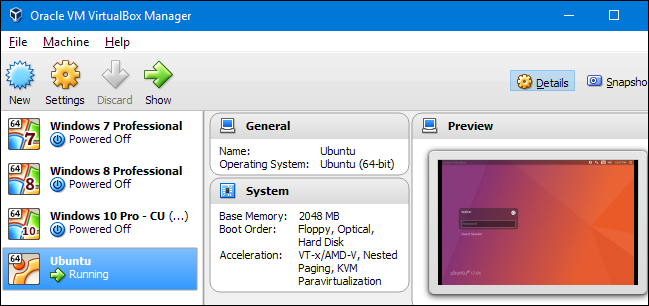
You can also run multiple VMs at the same time, but you’ll find yourself somewhat limited by your system resources. Each VM eats up some CPU time, RAM, and other resources.
您也可以同时运行多个VM,但是会发现自己受到系统资源的限制。 每个VM都会消耗一些CPU时间,RAM和其他资源。

为什么要创建虚拟机 (Why You’d Want to Create a Virtual Machine)
Aside from being good geeky fun to play around with, VMs offer a number of serious uses. They allow you to experiment with another OS without having to install it on your physical hardware. For example, they are a great way to mess around with Linux—or a new Linux distribution—and see if it feels right for you. When you’re done playing with an OS, you can just delete the VM.
虚拟机除了具有很好的令人讨厌的乐趣外,还具有许多重要用途。 它们使您可以尝试其他操作系统,而不必将其安装在物理硬件上。 例如,它们是解决Linux(或新Linux发行版)并查看是否适合您的好方法。 完成操作系统的播放后,您只需删除VM。
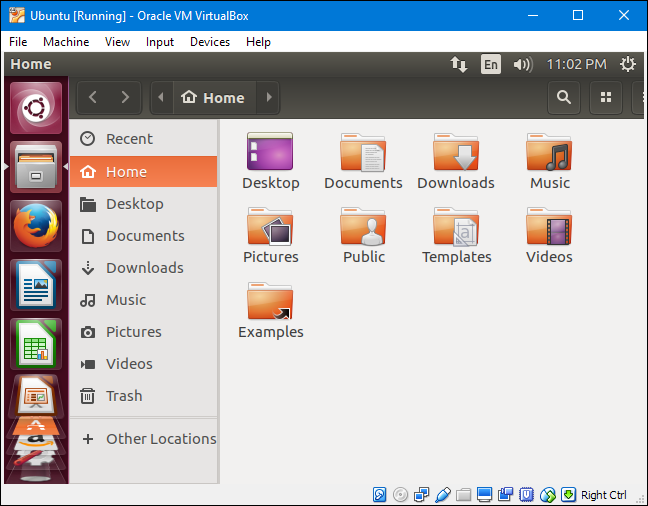
VMs also provide a way to run another OS’ software. For example, as a Linux or Mac user, you could install Windows in a VM to run Windows apps you might not otherwise have access to. If you want to run a later version of Windows—like Windows 10—but have older apps that only run on XP, you could install Windows XP into a VM.
VM还提供了一种运行其他OS软件的方法。 例如,作为Linux或Mac用户,您可以在VM中安装Windows以运行您原本无法访问的Windows应用。 如果您想运行更高版本的Windows(例如Windows 10),但拥有仅在XP上运行的较旧应用,则可以将Windows XP安装到VM中。
Another advantage VMs provide is that they are “sandboxed” from the rest of your system. Software inside a VM can’t escape the VM to tamper with the rest of your system. This makes VMs a safe place to test apps—or websites—you don’t trust and see what they do.
VM提供的另一个优势是,它们与系统的其余部分“ 沙盒化 ”。 VM内的软件无法逃脱VM来篡改系统的其余部分。 这使虚拟机成为测试您不信任并查看其功能的应用程序或网站的安全场所。
For example, when the “Hi, we’re from Windows” scammers came calling, we ran their software in a VM to see what they would actually do—the VM prevented the scammers from accessing our computer’s real operating system and files.
例如,当“嗨,我们来自Windows”诈骗者打来电话时, 我们在VM中运行他们的软件以查看其实际操作 — VM阻止了诈骗者访问计算机的真实操作系统和文件。
Sandboxing also allows you to run insecure OSes more safely. If you still need Windows XP for older apps, you could run it in a VM where at least the harm of running an old, unsupported OS is mitigated.
沙箱还可以使您更安全地运行不安全的操作系统。 如果您仍然需要Windows XP才能使用较旧的应用程序,则可以在VM中运行它,至少可以减轻运行不支持的旧OS的危害。
虚拟机应用 (Virtual Machine Apps)
There are several different virtual machine programs you can choose from:
您可以选择几种不同的虚拟机程序:
VirtualBox: (Windows, Linux, Mac OS X): VirtualBox is very popular because it’s open-source and completely free. There’s no paid version of VirtualBox, so you don’t have to deal with the usual “upgrade to get more features” upsells and nags. VirtualBox works very well, particularly on Windows and Linux where there’s less competition, making it a good place to start with VMs.
VirtualBox : (Windows,Linux,Mac OS X):VirtualBox非常流行,因为它是开源的并且完全免费。 没有VirtualBox的付费版本,因此您不必处理通常的“升级以获得更多功能”的追加销售和套利交易。 VirtualBox运作良好,特别是在竞争较少的Windows和Linux上,这使其成为从VM开始的好地方。
VMware Player: (Windows, Linux): VMware has their own line of virtual machine programs. You can use VMware Player on Windows or Linux as a free, basic virtual machine tool. More advanced features—many of which are found in VirtualBox for free—require upgrading to the paid VMware Workstation program. We recommend starting out with VirtualBox, but if it doesn’t work properly you may want to try VMware Player.
VMware Player : (Windows,Linux):VMware拥有自己的虚拟机程序系列。 您可以在Windows或Linux上使用VMware Player作为免费的基本虚拟机工具。 更高级的功能(其中许多可在VirtualBox中免费找到)需要升级到付费的VMware Workstation程序。 我们建议从VirtualBox开始,但如果它不能正常工作,则可能需要尝试VMware Player。
VMware Fusion: (Mac OS X): Mac users must buy VMware Fusion to use a VMware product, since the free VMware Player isn’t available on a Mac. However, VMware Fusion is more polished.
VMware Fusion : (Mac OS X):Mac用户必须购买VMware Fusion才能使用VMware产品,因为Mac上没有免费的VMware Player。 但是,VMware Fusion更加完善。
Parallels Desktop: (Mac OS X): Macs also have Parallels Desktop available. Both Parallels Desktop and VMware Fusion for Mac are more polished than the virtual machine programs on other platforms, since they’re marketed to average Mac users who might want to run Windows software.
Parallels Desktop : (Mac OS X):Mac也有Parallels Desktop。 与Parallels Desktop和Mac OS上的VMware Fusion相比,它们在其他平台上的虚拟机程序更加精致,因为它们是针对可能希望运行Windows软件的普通Mac用户销售的。
While VirtualBox works very well on Windows and Linux, Mac users may want to buy a more polished, integrated Parallels Desktop or VMware Fusion program. Windows and Linux tools like VirtualBox and VMware Player tend to be targeted to a geekier audience.
尽管VirtualBox在Windows和Linux上都能很好地运行,但Mac用户可能希望购买更加完善,集成的Parallels Desktop或VMware Fusion程序。 Windows和Linux工具(例如VirtualBox和VMware Player)倾向于面向更年轻的受众。
There are many more VM options, of course. Linux includes KVM, an integrated virtualization solution. Professional and Enterprise version of Windows 8 and 10—but not Windows 7—include Microsoft’s Hyper-V, another integrated virtual machine solution. These solutions can work well, but they don’t have the most user-friendly interfaces.
当然,还有更多的VM选项。 Linux包含集成虚拟化解决方案KVM 。 Windows 8和10(而非Windows 7)的专业版和企业版包括Microsoft的Hyper-V (另一种集成虚拟机解决方案)。 这些解决方案可以很好地工作,但是它们没有最人性化的界面。
设置虚拟机 (Setting Up a Virtual Machine)
Once you’ve decided on a VM app and gotten it installed, setting up a VM is actually pretty easy. We’re going to run through the basic process in VirtualBox, but most apps handle creating a VM the same way.
一旦确定了VM应用程序并安装了该应用程序,设置虚拟机实际上非常简单。 我们将在VirtualBox中完成基本过程,但是大多数应用程序都以相同的方式来创建VM。
Open up your VM app and click the button to create a new virtual machine.
打开您的VM应用程序,然后单击按钮创建一个新的虚拟机。

You’ll be guided through the process by a wizard that first asks which OS you’ll be installing. If you type the name of the OS in the “Name” box, the app will most likely automatically select the type and version for the OS. If it doesn’t—or it guesses wrong—select those items yourself from the dropdown menus. When you’re done, click “Next.”
向导将首先指导您完成安装过程,并首先询问您要安装哪个操作系统。 如果您在“名称”框中键入操作系统的名称,则该应用很可能会自动选择操作系统的类型和版本。 如果不是,或者猜错了,请从下拉菜单中自己选择这些项目。 完成后,单击“下一步”。

Based on the OS you plan to install, the wizard will preselect some default settings for you, but you can change them over the screens that follow. You’ll be asked how much memory to allocate to the VM. If you want something other than the default, select it here. Otherwise, just click “Next.” And don’t worry, you’ll be able to change this value later if you need to.
根据您计划安装的操作系统,向导将为您预选一些默认设置,但是您可以在随后的屏幕上进行更改。 系统将询问您要分配给VM的内存量。 如果要使用默认值以外的其他内容,请在此处选择。 否则,只需单击“下一步”。 不用担心,如果需要,您以后可以更改此值。
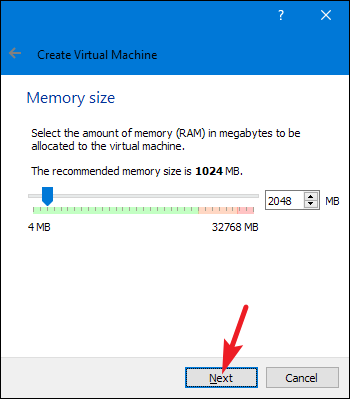
The wizard will also create the virtual hard disk file to be used by the VM. Unless you already have a virtual hard disk file you want to use, just select the option to create a new one.
该向导还将创建供VM使用的虚拟硬盘文件。 除非您已经拥有要使用的虚拟硬盘文件,否则只需选择该选项即可创建一个新的虚拟硬盘文件。
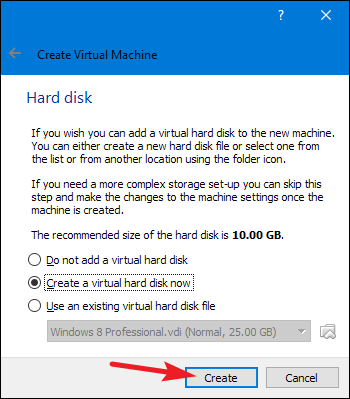
You’ll also be asked whether to create a dynamically allocated or fixed size disk. With a dynamically allocated disk, you’ll set a maximum disk size, but the file will only grow to that size as it needs to. With a fixed size disk, you’ll also set a size, but the file created will be that large from its creation.
系统还会询问您是否创建动态分配的磁盘或固定大小的磁盘。 对于动态分配的磁盘,您将设置最大磁盘大小,但是文件只会根据需要增大到该大小。 对于固定大小的磁盘,您还将设置大小,但是创建的文件与创建时一样大。
We recommend creating fixed size disks because, while they eat up a little more disk space, they also perform better—making your VM feel a bit more responsive. Plus, you’ll know how much disk space you’ve used and won’t get surprised when your VM files start growing.
我们建议创建固定大小的磁盘,因为尽管它们占用了更多的磁盘空间,但它们的性能也更好-使您的VM响应更快。 此外,您将知道已经使用了多少磁盘空间,并且在VM文件开始增长时不会感到惊讶。
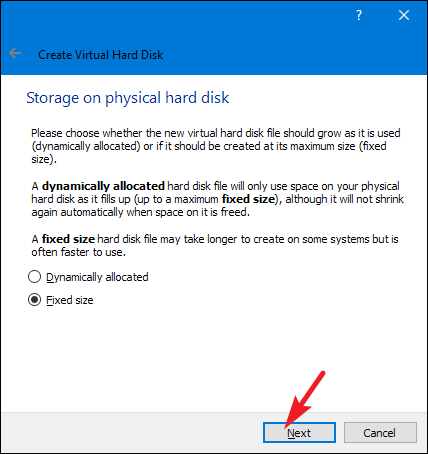
You’ll then be able to set the size of the virtual disk. You’re free to go with the default setting or change the size to suit your needs. Once you click “Create,” the virtual hard disk is created.
然后,您可以设置虚拟磁盘的大小。 您可以自由使用默认设置,也可以根据自己的需要更改大小。 单击“创建”后,将创建虚拟硬盘。

After that, you’re dumped back into the main VM app window, where your new VM should show up. Make sure the installation media you need is available to the machine—usually this involves pointing to an ISO file or real disc through the VM’s settings. You can run your new VM by selecting it and hitting “Start.”
之后,您将转回到主VM应用程序窗口,其中应显示新VM。 确保您所需的安装介质可用于机器-通常这涉及通过VM的设置指向ISO文件或真实光盘。 您可以通过选择新虚拟机并单击“开始”来运行它。

Of course, we’ve just touched on the basics of using VMs here. If you’re interested in more reading, check out some of our other guides:
当然,我们在这里仅涉及使用VM的基础知识。 如果您有兴趣阅读更多内容,请查看我们的其他一些指南:
Use Portable VirtualBox to Take Virtual Machines With You Everywhere
10 VirtualBox Tricks and Advanced Features You Should Know About
Have any other uses or tips for using VMs we didn’t touch on? Let us know in the comments!
我们没有接触过其他使用VM的用法或技巧吗? 让我们在评论中知道!
翻译自: https://www.howtogeek.com/196060/beginner-geek-how-to-create-and-use-virtual-machines/
初学者试机轨迹g代码





















 197
197











 被折叠的 条评论
为什么被折叠?
被折叠的 条评论
为什么被折叠?








